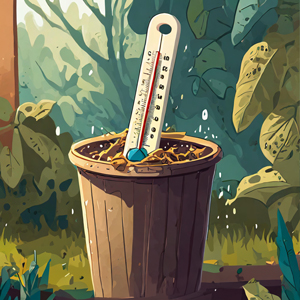
Hey there, fellow compost enthusiasts! I’m all about transforming kitchen scraps and shredded cardboard into that beautiful black gold: compost. But let’s be honest, nobody wants to wait forever for their compost pile to cook up. We all dream of that rich, crumbly goodness that nourishes our gardens as quickly as possible. That’s where a speed composting thermometer comes in.
I discovered the magic (or should I say science?) of using a compost thermometer. It completely transformed my composting game, and I’m here to share this secret weapon with you. So, grab a beverage, pull up a chair (or a garden stool!), and let’s dive into the world of speed composting with a thermometer!
Decoding the Stew: Why Temperature Matters in Composting
Before we get into thermometers, let’s talk about what’s happening inside your compost pile. Imagine it as a giant microscopic stew teeming with millions of busy decomposers – bacteria, fungi, and other little critters. These amazing organisms break down organic matter, turning it into nutrient-rich compost. But just like us humans, they have preferred working conditions – and temperature is key.
There are three main temperature zones in a speed composting pile:
- The Cool Zone (Below 100°F): This is where things get started. Microbes that like cooler temperatures begin the initial breakdown of organic materials. The composting process happens here, but it’s a slow and steady slog.
- The Warm Zone (100°F – 130°F): As the pile heats up, a different party of decomposers takes over. These thermophilic microbes love the warmth and get to work breaking things down much faster. This is where we start to see some real composting action!
- The Hot Zone (130°F – 160°F): Welcome to the composting sweet spot! Here, the thermophilic microbes are in high gear, cranking out finished compost at an impressive rate. This is the zone we’re aiming for in speed composting.
My aha moment! I realized that if I could keep my compost pile in the hot zone, I could achieve lightning-fast composting. But how could I monitor the temperature and make sure things were cooking along nicely? Enter the trusty compost thermometer!
The Humble Thermometer: Your Key to Success
A compost thermometer is a simple tool that measures the temperature deep within your compost pile. They come in two main varieties:
- Dial thermometers: These classic options have a long metal probe and a dial that displays the temperature. They’re easy to use and affordable.
- Digital thermometers: These fancy fellas offer digital readouts and sometimes even come with fancy features like minimum and maximum temperature readings.
No matter which type you choose, using a compost thermometer is a breeze. Just insert the probe into the center of your pile, wait a few seconds, and voila – you have your temperature reading! I recommend checking the temperature at least once a week, and more often for new piles that are just getting started.
Speed Composting Thermometer in Action:
Okay, now for the fun part: using your thermometer to create the perfect composting mix for speedy decomposition. Here’s how it works:
Reading the Signs: Let’s say your thermometer tells you the pile is running cool (below 100°F). This means the party’s not started yet, or maybe it’s slowed down a bit.
The Nitrogen Boost: Remember those hard-working microbes? They need a good balance of “food” to thrive. Cooler piles often lack nitrogen, which is essential for microbial growth. To heat things up, it’s time to add some “green” materials to your compost mix. Think kitchen scraps, coffee grounds, and fresh green grass clippings. These nitrogen-rich ingredients will kickstart microbial activity and get the temperature rising.
Taming the Flames: On the other hand, if your thermometer shows your pile is scorching hot (above 160°F), things might be cooking a little too aggressively. A super-hot pile can burn the good microbes and slow down decomposition. To cool things down, add some “brown” materials like shredded cardboard, (dry leaves), wood chips, or straw. These carbon-rich materials help balance out the nitrogen and create a more moderate temperature range for optimal composting.
Pro Tip for Experienced Composters: As you get more comfortable with composting, you can delve deeper into the concept of the C:N (carbon to nitrogen) ratio. This ratio refers to the balance of brown and green materials in your compost pile. A good starting point for a hot, fast-composting pile is a C:N ratio of around 30:1 (more browns than greens).
Reap the Rewards of Speed Composting: Benefits Galore
Using a thermometer to achieve speed composting offers a multitude of benefits:
- Faster Finished Compost: The most obvious perk is quicker access to that beautiful black gold for your garden. No more waiting months for your compost pile to finish!
- Happy Plants, Happy You: Rich, nutrient-dense compost made through speedy decomposition translates to healthier, more vibrant plants in your garden. Who doesn’t love that?
- Odor Adios (Mostly): A well-managed hot compost pile breaks down materials efficiently, minimizing the production of unpleasant odors. This is a win for you and your neighbors!
Embrace the Thermometer, Embrace Speed Composting!
There you have it, my composting friends! By incorporating a simple compost thermometer into your routine, you can unlock the secrets of speed composting. Remember, the key is to monitor your pile’s temperature and adjust your mix accordingly. With a little practice, you’ll be a speed composting pro in no time, churning out nutrient-rich compost to nourish your garden and impress your fellow green thumbs.
So, grab a thermometer, get mixing, and watch your compost pile transform into a hotbed of decomposition! Happy composting!
More Tools of the Trade
Composting Links:
United States Composting Council
EPA’s composting page
Cornell University Composting
The Compost Council